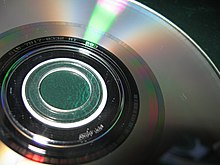
The compact disc (CD) is a digital optical disc data storage format that was co-developed by Philips and Sony to store and play digital audio recordings. In August 1982, the first compact disc was manufactured. It was then released in October 1982 in Japan and branded as Digital Audio Compact Disc.

CD-R is a digital optical disc storage format. A CD-R disc is a compact disc that can be written once and read arbitrarily many times.

In computing, an optical disc drive is a disc drive that uses laser light or electromagnetic waves within or near the visible light spectrum as part of the process of reading or writing data to or from optical discs. Some drives can only read from certain discs, but recent drives can both read and record, also called burners or writers. Compact discs, DVDs, and Blu-ray discs are common types of optical media which can be read and recorded by such drives.
Full-motion video (FMV) is a video game narration technique that relies upon pre-recorded video files to display action in the game. While many games feature FMVs as a way to present information during cutscenes, games that are primarily presented through FMVs are referred to as full-motion video games or interactive movies.

In optical storage, constant angular velocity (CAV) is a qualifier for the rated speed of any disc containing information, and may also be applied to the writing speed of recordable discs. A drive or disc operating in CAV mode maintains a constant angular velocity, contrasted with a constant linear velocity (CLV).

The Holographic Versatile Disc (HVD) is an optical disc technology that was expected to store up to several terabytes of data on an optical disc 10 cm or 12 cm in diameter. Its development commenced in April 2004, but it never arrived due to lack of funding. The company responsible for HVD went bankrupt in 2010.
The double-density compact disc (DDCD) is an optical disc technology developed by Sony and Philips using the same 780 nm laser wavelength as a compact disc. The format was announced in July 2000 and is defined by the Purple Book standard document. Unlike the compact-disc technology it is based on, DDCD was designed exclusively for data, with no audio capabilities.

Optical storage refers to a class of data storage systems that use light to read or write data to an underlying optical media. Although a number of optical formats have been used over time, the most common examples are optical disks like the compact disc (CD) and DVD. Reading and writing methods have also varied over time, but most modern systems as of 2023 use lasers as the light source and use it both for reading and writing to the discs. Britannica notes that it "uses low-power laser beams to record and retrieve digital (binary) data."
A video game accessory is a distinct piece of hardware that is required to use a video game console, or one that enriches the video game's play experience. Essentially, video game accessories are everything except the console itself, such as controllers, memory, power adapters (AC), and audio/visual cables. Most video game consoles come with the accessories required to play games out of the box : one A/V cable, one AC cable, and a controller. Memory is usually the most required accessory outside of these, as game data cannot be saved to compact discs. The companies that manufacture video game consoles also make these accessories for replacement purposes as well as improving the overall experience. There is an entire industry of companies that create accessories for consoles as well, called third-party companies. The prices are often lower than those made by the maker of the console (first-party). This is usually achieved by avoiding licensing or using cheaper materials. For the mobile systems like the PlayStation Portable and Game Boy iterations, there are many accessories to make them more usable in mobile environments, such as mobile chargers, lighting to improve visibility, and cases to both protect and help organize the collection of system peripherals to. Newer accessories include many home-made things like mod chips to bypass manufacturing protection or homemade software.
Utopia bootdisk is a booting program released on June 22, 2000 and created by the warez group Utopia, designed for playing pirated Sega Dreamcast games on standard CD-R discs. The bootdisk also allows the play of imported official Dreamcast GD-ROMs, bypassing the Dreamcast's region lockout. The Utopia bootdisk does not defeat the security used on original GD-ROM disks; instead, it uses an alternative boot method in the Dreamcast BIOS, which was originally intended for use with MIL-CDs. When loaded into a standard Dreamcast, the screen will display a spinning 3-D rendering of a reindeer alongside a message to insert a disc. Once a new disc is inserted and the Dreamcast lid is closed, the disc boots. Eventually, the bootdisk was rendered obsolete by "self-booting" pirate releases—games released in MIL-CD format that could boot without the need of the Utopia bootdisk. The bootdisk was developed using a pirated version of the Sega Katana SDK, with code to render the reindeer taken from an early Dreamcast teapot demo.
On an optical disc, a track (CD) or title (DVD) is a subdivision of its content. Specifically, it is a consecutive set of sectors on the disc containing a block of data. One session may contain one or more tracks of the same or different types. There are several kinds of tracks, and there is also a sub-track index for finding points within a track.
A mixed mode CD is a compact disc which contains both data and audio in one session. Typically the first track is a data track while the rest are audio tracks. The most common use for mixed mode CDs is to add CD-quality audio to video games on a CD.

CD-RW is a digital optical disc storage format introduced in 1997. A CD-RW compact disc (CD-RWs) can be written, read, erased, and re-written.

MIL-CD or Music Interactive Live CD is a compact disc format created by the video game company Sega in 1998. The main purpose of MIL-CD was to add multimedia functions to music CDs, for use in Sega's Dreamcast video game console. For example, MIL-CD music releases were to feature enhanced navigational menus, internet capabilities, and full-screen video. It was similar to tests done with Audio CD/CD-ROM combo discs on PCs, DVD-Video/DVD-ROM combo discs on PCs, game systems and DVD Players, as well as game/video combo discs for systems like the PlayStation 3.

The DVD is a digital optical disc data storage format. It was invented and developed in 1995 and first released on November 1, 1996, in Japan. The medium can store any kind of digital data and has been widely used for video programs or formerly for storing software and other computer files as well. DVDs offer significantly higher storage capacity than compact discs (CD) while having the same dimensions. A standard single-layer DVD can store up to 4.7 GB of data, a dual-layer DVD up to 8.5 GB. Variants can store up to a maximum of 17.08 GB.
As of 2021, multiple consumer-oriented, optical-disk media formats are or were available:

A CD-ROM is a type of read-only memory consisting of a pre-pressed optical compact disc that contains data. Computers can read—but not write or erase—CD-ROMs. Some CDs, called enhanced CDs, hold both computer data and audio with the latter capable of being played on a CD player, while data is only usable on a computer.










